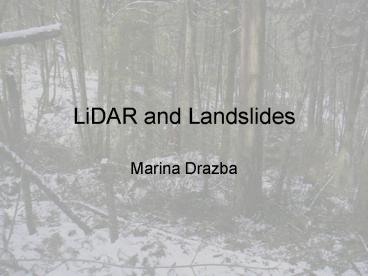LiDAR and Landslides - PowerPoint PPT Presentation
1 / 12
Title: LiDAR and Landslides
1
LiDAR and Landslides
- Marina Drazba
2
What is LiDARLight Detection And Ranging
Ground based devices are often used to monitor
small landslides of cliff faces that are
unstable.
Cartoon on how data is collected for processing.
Ground based has an accuracy within centimeters
and air borne LiDAR has an accuracy within 2
meters.
3
Location of Study Site and Geology
What a topographic map portrays isnt accurate,
and landslides are not visible. 124,000
4
Why LiDAR
Topo. image
LiDAR image
Haneberg, 2005
5
Why not aerial photography?
In heavily vegetated areas LiDAR can see through
the canopy and give us an image of the
subsurface. Landslides are still not visible
here.
6
The area scene here is the same area outlined in
red in the topo map and scene in the Google Earth
image. The landscape below can be seen, and
potential landslides can be mapped.
7
LiDAR
What can you do with LIDAR? Measure distance
Hummocky topography is visible Scarps are
visible Tongues and landslide toes are
visible Create contours from LiDAR with the same
projection and datum. The contours intervals can
be as a large as 50 feet or small as 5 feet.
The same cannot be said for topographic maps,
aerial photographs or satellite imagery. They
cannot see through the canopy of the trees. In
areas that are densely forested LiDAR is
extremely useful.
8
50 Foot Contoursat 110,000
9
15 Foot Contours at 16,000
10
5 Foot Contours at 13,000
11
Verifying landslides
12
Conclusion
- In areas with dense vegetation LiDAR is a useful
tool allowing one to see the surface beneath the
canopy. - The resolution is good enough to pick out
landslides with an area of 3,000 feet. - Ground based LiDAR can be used to monitor a small
cliff or landslides with cm accuracy.































